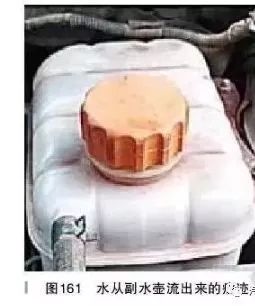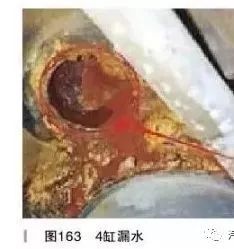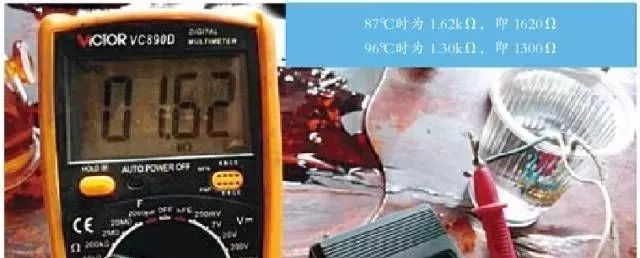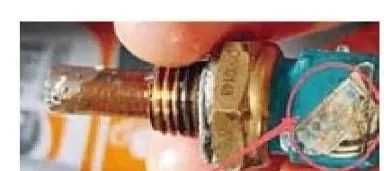Click to read👉If one day I stop repairing cars, what else can I do?
A 2009 Buick Excelle sedan, equipped with a 1.6L engine and automatic transmission, has a mileage of 147,261 km and was brought in for repairs due to high water temperature. According to the owner, even when the car is not started, if the water is filled up at night, the next day the water in the overflow tank will be significantly lower. After driving for a while and parking, a noticeable boiling sound can be heard from the cooling system.
Fault Diagnosis:
Upon opening the engine compartment, it was found that coolant was visibly leaking from the overflow tank, as shown in Figure 161, indicating high water temperature or poor circulation in the cooling system. Checking the overflow tank, the coolant was empty. After filling it with clean water and starting the engine, after more than 10 minutes, there was no visible leak from the engine.

However, the water temperature gauge on the dashboard did not rise at all. Touching the upper water pipe, it was found to be very hot, and the lower water pipe was also hot, indicating a significant difference between the perceived temperature and the actual temperature. Accessing the engine data stream, it was found that the water temperature received by the engine ECU was 45°C, while the temperature measured directly on the upper water pipe was 66.7°C, as shown in Figure 162, indicating a difference of about 20°C. Considering the temperature difference between the rubber inside and outside, the actual temperature difference is estimated to be 24°C. When the engine received a temperature of 67°C, the measured temperature outside was 84°C, indicating that the engine was receiving incorrect water temperature data. Clearly, when the actual water temperature reached the point to activate the fan, the engine ECU did not receive the water temperature information required to drive the cooling fan, resulting in excessive water pressure inside the engine, causing water to spray out from the overflow tank. This was a major reason for the issue.

The problem was identified, but how to find a correct water temperature sensor to replace it? First, we need to know the resistance values and temperatures of the water temperature sensor when the fan is running at low and high speeds. Therefore, we connected a variable resistor to the original water temperature sensor’s connector (replacing the water temperature sensor). While the engine was running, we slowly adjusted the variable resistor. The results showed that when the fan was running at low speed, the temperature data received by the engine ECU was 96°C, and the resistance of the variable resistor at that time was 211Ω; when the fan was running at high speed, the temperature data received by the engine ECU was 100°C, and the resistance of the variable resistor was 178Ω.
With these two data points, we can check the resistance of the new water temperature sensor. If it is very close, that would be ideal. If not, we can find a resistor that is close to 211Ω at 96°C to solve the problem. If a suitable resistor cannot be found, we can use a series resistor if it is too small, or a parallel resistor if it is too large. How large should the parallel resistor be? Taking the original resistance of this car as an example, at 96°C the resistance is 1.30kΩ (as shown in Figure 165). If we need to find out how many ohms of resistance to parallel at 96°C?

We assume we need to parallel a fixed resistor (a resistor that does not change with temperature) denoted as β. According to Ohm’s law, we have:1/1300 + 1/β = 1/211, which gives us β = 251.9Ω. We can parallel a resistor of about 250Ω to achieve the desired effect. If such a resistor is paralleled, during winter, the water temperature gauge may initially show some issues (initial water temperature high, possibly making it difficult to start the cold engine, and there may be some acceleration issues before the water temperature rises—lean mixture), but if we explain the reasons to the customer, the problem can be resolved.
Fault Resolution:
Replacing the correct water temperature sensor and the leaking cylinder head resolved the issue.
Fault Summary:
(1) This car has likely been repaired several times at other repair shops (the owner mentioned it was serviced in Nanning), but the fault was not resolved. After arriving at my shop, I systematically checked step by step based on observation (looking, observing), data analysis (checking data stream), and actual measurement of the upper water pipe temperature against the water temperature information received by the engine ECU, ultimately identifying the cause of the fault.
(2) The owner should be advised to go to a qualified and skilled repair shop for vehicle maintenance and repairs. In this case, due to high water temperature, the water temperature sensor and overflow cap had been replaced at other repair shops (as shown in Figure 166, the water temperature sensor has two labels), but they did not consider that the temperature change curve of the water temperature sensor was different from the original factory requirements, leading to the engine ECU receiving incorrect water temperature data that was 20°C lower than the actual temperature, causing the fan not to operate when it should, resulting in accelerated aging of the water pump due to high temperature and water leakage.

(3) The water leakage in this car, while driving, did not show any signs due to natural air cooling, but after parking, due to the lack of natural air cooling, the water pressure in the cooling system increased, causing water to leak from the overflow tank, resulting in less water in the overflow tank the next day, with no obvious signs other than the overflow tank.
Click to read👉After replacing the rear brake pads during the Qingming Festival, I ended up losing 4,800 yuan!
Largest Auto Repair Case Database
Only sending useful content
Auto Repair Case: qixiuanli
Common Problems | Timing Adjustment | Auto Repair Techniques | Maintenance Reset
